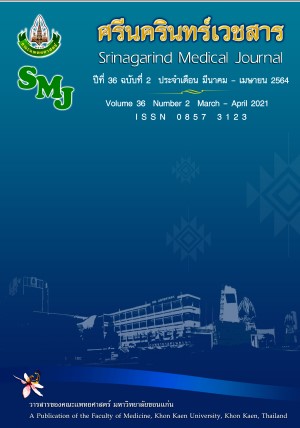Prevalence and Clinical Features of Polycystic Ovary Syndrome in Thai Adolescents
Keywords:
Polycystic ovary syndrome; prevalence, adolescent; hyperandrogenism; oligomenorrheaAbstract
Background and objective: This study was conducted to assess the prevalence and clinical features of polycystic ovary syndrome (PCOS) among high school-age Thai adolescents in Khon Kaen.
Materials and Methods: This was a cross sectional study in which 385 adolescents aged 15 to 18 years were enrolled. The diagnosis of PCOS was made according to the criteria issued by the International Consortium of Pediatric Endocrinology (ICPE).
Results: The prevalence of PCOS among participants was1.81%. Oligomenorrhea was the most common form of abnormal menstruation among participants with PCOS. Of the seven participants with PCOS, five had evidence of clinical hyperandrogenism according to their modified Ferriman-Gallwey scores, and two were noted as having clinical hyperandrogenism based on the presence of moderate acne vulgaris. Five of the seven participants with PCOS were found to have biochemical hyperandrogenism.
Conclusion: The prevalence of PCOS in the present study was 1.81%. The most common abnormal menstruation pattern among the patients with PCOS was oligomenorrhea. Clinical hyperandrogenism was noted in the majority of cases.
References
2. McCartney CR, Marshall JC. CLINICAL PRACTICE. Polycystic Ovary Syndrome. N Engl J Med 2016; 375(1): 54-64.
3. Rothenberg SS, Beverley R, Barnard E, Baradaran-Shoraka M, Sanfilippo JS. Polycystic ovary syndrome in adolescents. Best Pract Res Clin Obstet Gynaecol 2018; 48: 103-114.
4. American College of Obstetricians and Gynecologists' Committee on Practice Bulletins—Gynecology. ACOG Practice Bulletin No. 194: Polycystic Ovary Syndrome. Obstet Gynecol 2018; 131(6): e157-e171.
5. Carmina E. Diagnosis of polycystic ovary syndrome: from NIH criteria to ESHRE-ASRM guidelines. Minerva Ginecol 2004; 56(1): 1-6.
6. Rotterdam ESHRE/ASRM-Sponsored PCOS consensus workshop group. Revised 2003 consensus on diagnostic criteria and long-term health risks related to polycystic ovary syndrome (PCOS). Hum Reprod 2004; 19(1): 41-47.
7. Azziz R, Carmina E, Dewailly D, Diamanti-Kandarakis E, Escobar-Morreale HF, Futterweit W, et al. The Androgen Excess and PCOS Society criteria for the polycystic ovary syndrome: the complete task force report. Fertil Steril 2009; 91(2): 456-488.
8. Ibanez L, Oberfield SE, Witchel S, Auchus RJ, Chang RJ, Codner E, et al. An International Consortium Update: pathophysiology, diagnosis, and treatment of Polycystic ovarian syndrome in adolescence. Horm Res Paediatr 2017; 88(6): 371-395.
9. Rosenfield RL. The diagnosis of Polycystic ovary syndrome in adolescents. Pediatrics 2015; 136(6): 1154-1165.
10. WHO. Adolescent health in the South-East Asia Region: World Health Organization; [February 28, 2020]. Available from: https://www.who.int/southeastasia/health-topics/adolescent-health.
11. Escobar-Morreale HF, Carmina E, Dewailly D, Gambineri A, Kelestimur F, Moghetti P, et al. Epidemiology, diagnosis and management of hirsutism: a consensus statement by the Androgen Excess and Polycystic Ovary Syndrome Society. Hum Reprod Update 2012; 18(2): 146-170.
12. Zhao X, Ni R, Li L, Mo Y, Huang J, Huang M, et al. Defining hirsutism in Chinese women: a cross-sectional study. Fertil Steril 2011; 96(3): 792-796.
13. Carmina E, Oberfield SE, Lobo RA. The diagnosis of polycystic ovary syndrome in adolescents. Am J Obstet Gynecol 2010; 203(3): 201.e1-5.
14. Musmar S, Afaneh A, Mo'alla H. Epidemiology of polycystic ovary syndrome: a cross sectional study of university students at An-Najah national university-Palestine. Reprod Biol Endocrinol 2013; 11: 47.
15. Hashemipour M, Faghihimani S, Zolfaghary B, Hovsepian S, Ahmadi F, Haghighi S. Prevalence of polycystic ovary syndrome in girls aged 14-18 years in Isfahan, Iran. Horm Res 2004; 62(6): 278-282.
16. Esmaeilzadeh S, Delavar MA, Amiri M, Khafri S, Pasha NG. Polycystic ovary syndrome in Iranian adolescents. Int J Adolesc Med Health 2014; 26(4): 559-565.
17. Kaewnin J, Vallibhakara O, Arj-Ong Vallibhakara S, Wattanakrai P, Butsripoom B, Somsook E, et al. Prevalence of polycystic ovary syndrome in Thai University adolescents. Gynecol Endocrinol 2018; 34(6): 476-480.
18. Nidhi R, Padmalatha V, Nagarathna R, Amritanshu R. Prevalence of polycystic ovarian syndrome in Indian adolescents. J Pediatr Adolesc Gynecol 2011; 24(4): 223-227.
19. Yildiz BO, Bozdag G, Yapici Z, Esinler I, Yarali H. Prevalence, phenotype and cardiometabolic risk of polycystic ovary syndrome under different diagnostic criteria. Hum Reprod 2012; 27(10): 3067-3073.
20. Witchel SF, Oberfield S, Rosenfield RL, Codner E, Bonny A, Ibanez L, et al. The Diagnosis of Polycystic Ovary Syndrome during Adolescence. Horm Res Paediatr 2015; 83: 376-389.
21. Misra A. Ethnic-Specific Criteria for Classification of Body Mass Index: A Perspective for Asian Indians and American Diabetes Association Position Statement. Diabetes Technol Ther 2015; 17(9): 667-671.
22. Aydin Y, Hassa H, Burkankulu D, Arslantas D, Sayiner D, Ozerdogan N. What is the Risk of Metabolic Syndrome in Adolescents with Normal BMI who have Polycystic Ovary Syndrome? J Pediatr Adolesc Gynecol 2015; 28(4): 271-274.
23. Legro RS, Arslanian SA, Ehrmann DA, Hoeger KM, Murad MH, Pasquali R, et al. Diagnosis and treatment of polycystic ovary syndrome: an Endocrine Society clinical practice guideline. J Clin Endocrinol Metab 2013; 98(12): 4565-4592.
24. Screening and Management of the Hyperandrogenic Adolescent: ACOG Committee Opinion, Number 789. Obstet Gynecol 2019; 134(4): e106-e114.




